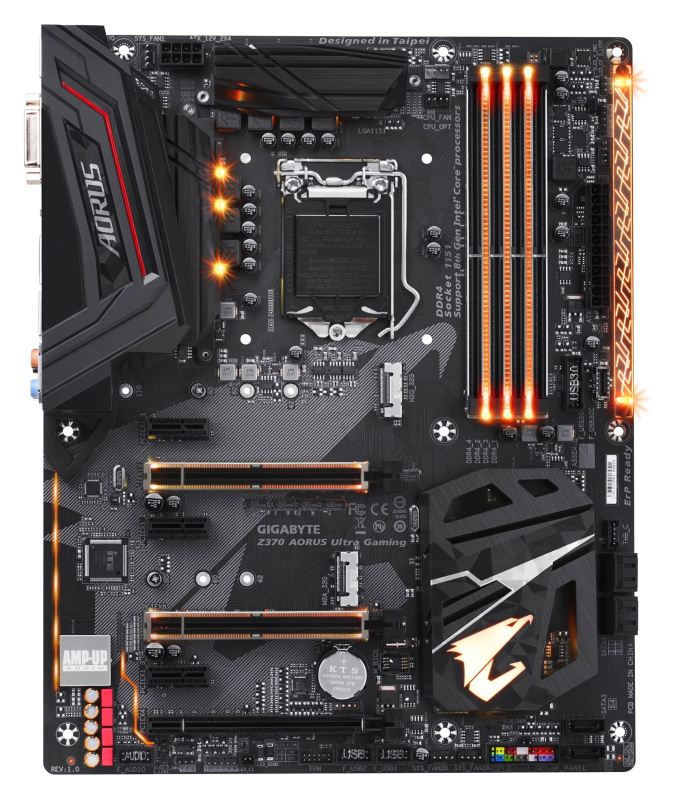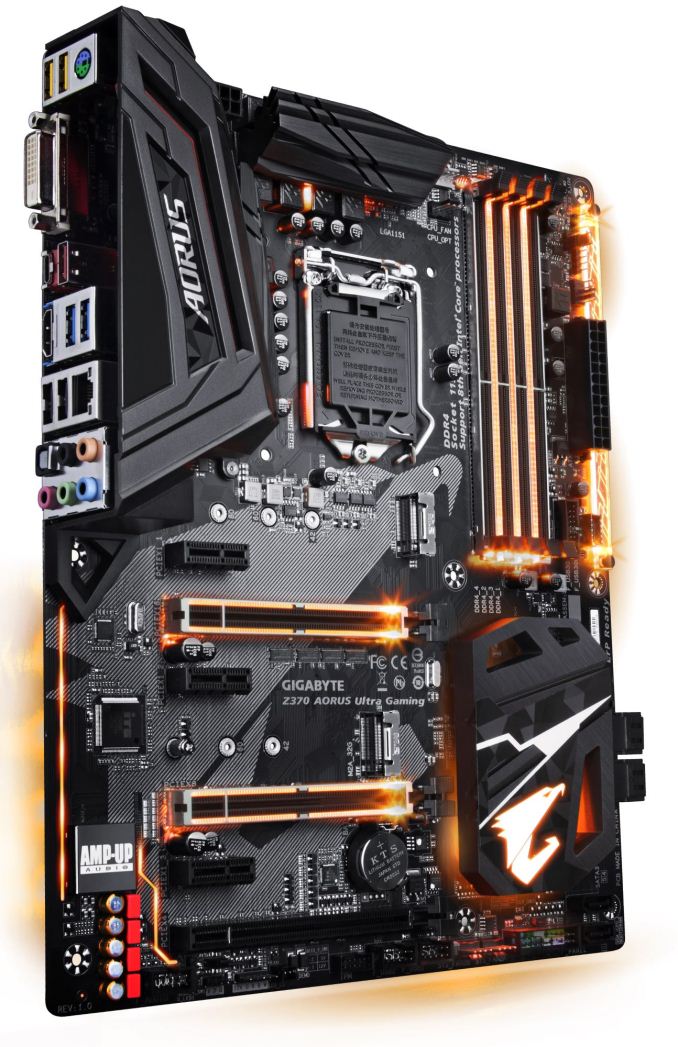Analyzing Z370 for Intel's 8th Generation Coffee Lake: A Quick Look at 50+ Motherboards
by Ian Cutress, Anton Shilov, Joe Shields & Gavin Bonshor on October 20, 2017 2:00 PM ESTGIGABYTE Z370 Ultra Gaming
The next board we will take a high-level look at is the Z370 Ultra Gaming. The Ultra Gaming appears to fall somewhere in the middle of the AORUS lineup offering a mix of features.
Appearance wise, the PCB is black with the AORUS bird stenciled in from the Audio area going through the PCIe slots and ending around the bottom of the CPU socket. RGB LEDs are used in multiple locations including around the VRM area, between the memory slots, and a strip on the right side going from mid-board to the top. The separation line between the audio section and the rest of the motherboard has LEDs, as well as the two fortified PCIe slots and the PCH heatsink. Compared to the Gaming 5 and Gaming 7, it loses LEDs on the VRM heatsink and back panel shroud. On the board there are also two 5-pin headers for external RGBW LED strips, both supporting true white, and two more regular RGB headers, all of which are controlled by the RGB Fusion Software. The Ultra Gaming board uses a different VRM with what looks like 7 phases as opposed to the 10 phase the Gaming 5/7 runs with. We can see it is using International Rectifier chokes, likely to be the same 40A/50A models we have seen on other GIGABYTE boards. Two separate heatsinks cover each set of VRMs to help keep them cool.
The board uses four reinforced memory slots supporting dual-channel DDR4 with capacity up to 64GB, and speeds supported up to DDR-4000. There are two steel protected full-length PCIe 3.0 slots, operating at x16 and x8 respectively, using lanes sourced from the CPU. There is another unprotected full-length PCIe 3.0 slot at the bottom of the board; it is limited to x4 bandwidth from the chipset and used for add-on cards. Additionally, there are three PCIe 3.0 x1 slots to round out PCIe capabilities. The board supports 2-way SLI via the reinforced slots, and 3-Way Crossfire using all the full-length PCIe slots.
For storage, the Z370 AORUS Ultra Gaming gives users a total of six SATA ports and two M.2 PCIe 3.0 x4 slots. The first M.2 connector can hold up to 110mm drives and is located above all the PCIe slots. The second slot, found between the second PCIe x1 slot and second full-length slot, supports up to 80 mm drives. There are several fan headers scattered around the board, five according to my cursory glance, located around the socket and to the right, as well across the bottom of the board. Audio duties are handled by the latest Realtek ALC1220 codec while networking is taken care of by a single Intel I219-V NIC. The Ultra Gaming also includes a Thunderbolt 3 header located just above the SATA ports for a TB3 add-in card.
The board supports USB 3.1 (10 Gbps) with a Type-A and Type-C headers found on the rear I/O only. There is a USB 3.1 (5 Gbps) header for the chassis, although we find four ports on the rear panel. There is a USB 3.1 (10 Gbps) style header on the board as well, although from what we can determine, this has only 3.1 (5 Gbps) bandwidth.
Boards further up the stack like the Gaming 5 offer an additional M.2 slot, or in the case of the Gaming 7, the additional M.2 slot and better audio hardware. The Ultra Gaming does not have onboard power and reset buttons nor a debug LED - it would appear these are options commonly targeted towards enthusiasts. In that respect, the stripped down Ultra Gaming is focusing on users who set the system up, then leave it until it is time to upgrade.













83 Comments
View All Comments
Hxx - Monday, October 23, 2017 - link
no they're not. the gigabyte gaming 5 is $200 the gaming 7 is $250 (just so happen I was looking at some gigabyte boards). Those prices are as high as z270 when it came out. In comparison, you could get a z270 gaming 7 for like 150. That's just one example I'm sure there are others. There is definitely a premium built into these boards for something that is nothing more than a stop gap and that will become obsolete 6 months from now.Hixbot - Sunday, October 22, 2017 - link
Only one board with 10GBE? That's dissapointing.pvdw - Sunday, October 22, 2017 - link
I'd really like reviews of the mITX boards, particularly the ASRock Z370 Gaming-ITX/ac. I'll be building a portable gaming + workstation to go in this case when it comes in January: https://www.kickstarter.com/projects/33753221/dan-...Thanks!
pvdw - Sunday, October 22, 2017 - link
mITX -> ITXTwister292 - Sunday, October 22, 2017 - link
The Aorus Gaming 5's M.2 slots are actually 2x110mm and 1x80mm accoding to the manual. It's also visible...the M2 slot at the top and the middle slot have 4 positions for the screws, the bottom slot has only 3.takeshi7 - Monday, October 23, 2017 - link
Asus, stop putting electrolytic capacitors on your TUF boards. The main reason I buy TUF boards is for the all solid caps. I don't care about "Nichicon gold" audio caps, and anyone who's serious about audio will have an external DAC or another sound card anyways. STAHHHP!Samus - Monday, October 23, 2017 - link
Having a "quick look" at 50 motherboards is somewhat an oxymoron, isn't it?tezpez - Tuesday, October 24, 2017 - link
May have spotted an error in the article - Asus Strix 370-F doesn't have wifi, whereas this page says it does: https://www.anandtech.com/show/11860/z370-motherbo...number58 - Tuesday, October 24, 2017 - link
The pictures for the Gigabyte Z370 Gaming K3 are actually some MSI mini itx board.pjcamp - Tuesday, October 24, 2017 - link
No, question 1 is "do I give 2 sh!ts about gaming?" How about a little help for people who are NOT twitch fanatics?